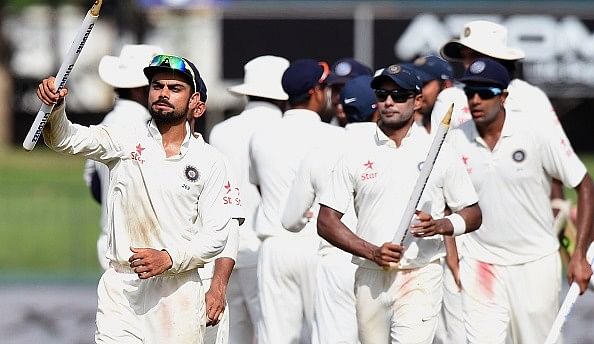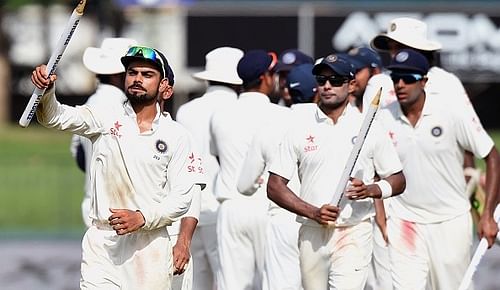
India's away tours' sojourn: Satisfactory grades in a tough examination

The googly from Amit Mishra on the last delivery of the 85th over of Sri Lanka’s second innings overwhelmed the number 11 batsman Nuwan Pradeep and sealed a famous, rare series win for India in the island nation.
Celebrations and accolades followed, and a sense of satisfaction settled as you contemplated India’s away tours’ log-book for the last two seasons (Oct 2013-Sep 2015). India travelled to six Test-playing nations within 21 months, played 17 matches, won only three but ticked a lot of boxes affirmatively.
Murali Vijay, Shikhar Dhawan, Cheteshwar Pujara, Virat Kohli, Rohit Sharma, Ajinkya Rahane, Mahendra Singh Dhoni were India’s top seven in the first Test against South Africa in Johannesburg in December 2013; KL Rahul, Pujara, Rahane, Kohli, Rohit, Stuart Binny, Naman Ojha formed the top seven in the latest Test at Colombo versus Sri Lanka.
Ravichandran Ashwin, Zaheer Khan, Ishant Sharma, Mohammad Shami were the frontline bowlers then and Ashwin, Mishra, Ishant, Umesh Yadav in the recently concluded Test. Dhoni retired (from Tests) in that phase, and the likes of Gautam Gambhir and, more recently, Harbhajan Singh were given comeback opportunities.
India Test caps numbered 281 to 285 were awarded to five players (Binny, Pankaj Singh, Karn Sharma, Rahul and Ojha) during this period. A nucleus was allowed to form and permitted to find its path, disregarding the statistics – and rightly so.
Among the talking points, the personnel in the batting line-up and their positions have been the subject of most of the focus. Let us put up the numbers first (Innings-Runs-Average-100s): Kohli (33-1559-48.71-7), Rahane (32-1345-46.37-4), Vijay (29-1312-45.24-3), Dhawan (23-915-39.78-3) and Pujara (26-908-36.32-2) feature as the top contributors.
While Vijay has blossomed on almost every tour, Dhawan’s performances have been hot and cold. Rahul flattered to deceive, but his brief stays helped create the perception of him being a decent long-term investment option.
Pujara began this phase on a solid footing and by the time it ended, he was pushed to perform for survival. Among all the batsmen, Kohli and Rahane exuded positive vibes on almost every trip; the above statistics are testimony to this view.
The Rohit conundrum continued its fascinating tale, both in terms of his place in the side and his position in the line-up. Despite promising personnel, the problem of the batting order hasn’t been sorted out just yet, and doesn’t appear likely to anytime soon.
Ashwin’s reputation on foreign soil had suffered heavy criticism during the 0-8 phase, which has changed gradually in the last two seasons. Ishant has now assumed the position of the spearhead in the bowling attack, although not by virtue of being the leader-in-waiting, but more so due to his experience. Yet, both in England and Sri Lanka, he managed to raise his game significantly to shift the momentum in India’s favour in the crunch moments.
Indian fans have always yearned to have an Indian quickie rattle opposition batsmen with pace and bounce. The turn of the century saw this happening, albeit in patches. With the likes of Shami, Yadav and Varun Aaron being liberated to flaunt their natural abilities, the wishes of the past have started materializing more regularly.
For some strange reason, however, Indian batsmen have started struggling against spin, especially on away tours. A part of the problem has been attributed to lack of quality in the spin department in the domestic circuit, which is reflecting in the limited number of spinners pushing for a spot in the Indian team.
One of India’s perennial problems has been the absence of a ‘genuine’ all-rounder. Both Ravindra Jadeja and Binny were tried in this phase, yet neither grasped the opportunity for cementing a place in the side.
The present team management has the mindset of fielding five bowlers and five frontline batsmen, which creates space for multi-skilled players. Dhoni’s retirement from this format has left a major hole, something which has many seekers. With the team in the transition phase and multiple voids to plug, India’s domestic circuit too should be boosted by this situation.
India should be satisfied, if not happy, with the scorelines endured during this period viz. 0-1 (2), 0-1 (2), 1-3 (5), 0-2 (4), 0-0 (1), 2-1 (3). The lack of baggage benefited the team to go through the tough tests with naïve, ambitious intentions.
The ‘process’ which was initiated in the Dhoni-Fletcher phase has started bearing some success under the management of Kohli-Shastri. India did miss a few opportunities in South Africa, Australia and Sri Lanka and slipped from a commanding position a couple of times, but for a side looking forward towards a new era, this has been a decent performance in a tricky exam.
For a batsman who has weathered a nippy first day of a Test, the second day is often his time for redemption. Likewise, India now has the chance to cash in, having a long home calendar with no burden of international cricket rigours.
The averages will improve, spinners will become India’s key elements, the position on the rankings table will rise. But none of that will come easy in a long series against the top-ranked Test team in the world!